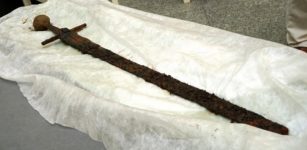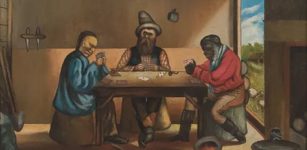Brahan Seer – A Legendary Scottish Nostradamus
A. Sutherland - AncientPages.com - There is an old legend that is still very much alive. It is about a Seer of the Clan Mackenzie, known as Coinneach, the Brahan Seer, who lived in the 17th Century and made several prophecies that have come true (including oil discovery in the North Sea).
Uig, Isle of Lewis. Brahan Seer was probably born near Uig, on the Isle of Lewis, the northernmost island of the Outer Hebrides, of Scotland's northern coast, and worked as a farm laborer on the Brahan estates; home to the powerful Seaforth MacKenzies, a clan of the Scottish nobles.
'Brahan Seer,' Scotland's most famous prophet, lived in the 17th Century.
He was probably born near Uig, on the Isle of Lewis, the northernmost island of the Outer Hebrides, of Scotland's northern coast, and worked as a farm laborer on the Brahan estates; home to the powerful Seaforth MacKenzies, a clan of the Scottish nobles.
Many of his prophecies originate from the place owned by the Mackenzies, who probably descended from the ancient royal house of Lorn. The clan held lands in Ross-shire, stretching from the Outer Hebrides in the west to the Black Isle in the east.
Brahan Seer lived around the same time as the famous Nostradamus, often compared to him. However, many of the predictions attributed to the Scottish Seer are literal and straightforward and not cloaked in word games, riddles, and allegory as those of Nostradamus.
Curiously, many of Brahan See's predictions have come true with a high degree of accuracy. He could predict futuristic events.
Legend has it that he gained his gift of 'Second Sight' after napping on a fairy hill and finding a small, blue, black stone with a hole in its center in his coat. This stone allowed him to view the future.
Legend has it that he gained his gift of ‘Second Sight’ after napping on a fairy hill and finding a small, blue and black stone with a hole in its center, in his coat. This stone allowed him to view the future. Credit: Adobe Stock - Rainer Fuhrmann
He reportedly foretold of the Battle of Culloden in 1745. He spoke of "streams of fire and water" running beneath the streets of Inverness and into every home. In the 19th Century, gas and water pipes fulfilled this prediction.
His predictions included World War II when he said, "when it is possible to cross the River Ness dryshod in five places, a frightful disaster would strike the whole world.." and the making of the Caledonian Canal in 1822:
"The time will come when full-rigged ships will be seen sailing eastwards and westwards by the back of Tomnahurich, near Inverness."
The Seer told of a time when Scotland would again have its own Parliament. He foretold this when men could walk dry-shod from England to France. In 1994, the Channel Tunnel opened. A few years later, the first Scottish Parliament since 1707 took its seats.
 The seer was put to death in a barrel of tar close to where the Chanonry Point lighthouse on the Black Isle is today.
The seer was put to death in a barrel of tar close to where the Chanonry Point lighthouse on the Black Isle is today.
He predicted the doom of the noble Mackenzie family who had him executed: the last male heir of this line would be deaf. In the 19th Century, this came true, as the last of the Mackenzies lost his hearing in his youth.
He also predicted that the lands of Kintail, in the County of Ross, would be sold, and the male line becomes extinct." This prophecy was well known in the north long before its fulfillment and was certainly not made after the event.
Legend has it that, unfortunately for the Seer, the accuracy and precision of his bizarre eventually became his downfall.
The Seer was put to death in a barrel of tar close to where the Chanonry Point lighthouse on the Black Isle is today.
While the Earl was away in Paris, his wife Isabella called for the Brahan Seer to tell her about her husband. The Seer seemed reluctant to give any information, but finally, he said that her husband was on his knees in front of a beautiful French lady. It was too much for Lady Isabella, who became furious and threw the poor Seer thrown into a barrel of tar. As he was being dragged off to meet his terrible fate, he made his last and most ominous prediction as a curse on the family of MacKenzie:
"The line of Seaforth will come to an end in sorrow. I see the last head of his house both deaf and dumb. He will be the father of four fair sons, all of whom he will follow to the tomb. He will live careworn and die mourning, knowing that the honors of his line are to be extinguished forever, that no future chief of the Mackenzies shall bear rule at Brahan or in Kintail."
In 1783, Francis Humberston Mackenzie inherited the title. He was indeed deaf and mute due to a childhood attack of scarlet fever. He had four children, all of whom died prematurely, fulfilling the final prophecy.
Many of his prophecies were fulfilled, and tradition holds that his death by burning in tar followed his final prediction of the doom of the House of Seaforth."
Did the Scottish prophet exist? Was he burned to death, as the legend says? Is the story of the Brahan Seer only a deeply rooted tale that survived until today?
No contemporary or historical records of any such person ever exist; there are only oral tales passed down through generations, which still have great value for the Scottish people.
To this day, the Brahan Seers' predictions are remembered in this part of the mysterious Scottish highlands.
Written by – A. Sutherland AncientPages.com Staff Writer
Updated on January 14, 2024
Copyright © AncientPages.com All rights reserved. This material may not be published, broadcast, rewritten or redistributed in whole or part without the express written permission of AncientPages.com
Expand for referencesMore From Ancient Pages
-
 On This Day In History: ‘Diamond Sutra’ The Oldest Dated, Printed Book Is Published – On May 11, 868
News | May 11, 2016
On This Day In History: ‘Diamond Sutra’ The Oldest Dated, Printed Book Is Published – On May 11, 868
News | May 11, 2016 -
 Unique Maya Center Of Copán With History Recorded In 2500 Hieroglyphics
Civilizations | Nov 7, 2018
Unique Maya Center Of Copán With History Recorded In 2500 Hieroglyphics
Civilizations | Nov 7, 2018 -
 17th Century Medical Pop-Up Book Digitized
Archaeology | Jan 16, 2016
17th Century Medical Pop-Up Book Digitized
Archaeology | Jan 16, 2016 -
 Strange Cave Drawings Of Unknown Beings And Animals In Japan Puzzle Historians
Featured Stories | Dec 2, 2019
Strange Cave Drawings Of Unknown Beings And Animals In Japan Puzzle Historians
Featured Stories | Dec 2, 2019 -
 Cave Art In ‘Painting Room’ – At Ojo Guareña (Burgos) Is Over 12,000 Years Old
News | Oct 2, 2020
Cave Art In ‘Painting Room’ – At Ojo Guareña (Burgos) Is Over 12,000 Years Old
News | Oct 2, 2020 -
 Mysterious Bronze Age Viksö Helmets With Horns Related To Myths, Holy Animals And Divine Power
Artifacts | Feb 27, 2018
Mysterious Bronze Age Viksö Helmets With Horns Related To Myths, Holy Animals And Divine Power
Artifacts | Feb 27, 2018 -
 Rare Gladiator Tombs Found In Ancient City Of Anavarza In Southern Turkey
Archaeology | Aug 16, 2022
Rare Gladiator Tombs Found In Ancient City Of Anavarza In Southern Turkey
Archaeology | Aug 16, 2022 -
 Unique Medieval Perfectly Preserved Sword Found In The Odra River, Poland
Archaeology | Aug 12, 2020
Unique Medieval Perfectly Preserved Sword Found In The Odra River, Poland
Archaeology | Aug 12, 2020 -
 Mystery Of The Okefenokee Swamp Deepens: Unexplained Sightings Of Unknown Beings, Puzzling Lights, And Giant Skeletons Reported
Featured Stories | Nov 26, 2024
Mystery Of The Okefenokee Swamp Deepens: Unexplained Sightings Of Unknown Beings, Puzzling Lights, And Giant Skeletons Reported
Featured Stories | Nov 26, 2024 -
 Beautiful Gold ‘Lynx’ Earrings Discovered In The Ruins Of The Ancient Lost City Of Ani Go On Display In 2023
Archaeology | Dec 29, 2022
Beautiful Gold ‘Lynx’ Earrings Discovered In The Ruins Of The Ancient Lost City Of Ani Go On Display In 2023
Archaeology | Dec 29, 2022 -
 Unexpected Discovery Of Two Viking Swords In Upright Position In Sweden
Archaeology | Oct 27, 2022
Unexpected Discovery Of Two Viking Swords In Upright Position In Sweden
Archaeology | Oct 27, 2022 -
 Ancient City Of Metsamor – Captured And Destroyed By Argishti I, The Ruler Of Urartu
Civilizations | Sep 11, 2015
Ancient City Of Metsamor – Captured And Destroyed By Argishti I, The Ruler Of Urartu
Civilizations | Sep 11, 2015 -
 Reconstruction Of Five-Story Patara Lighthouse Built By Roman Emperor Nero – Begins
Archaeology | May 30, 2019
Reconstruction Of Five-Story Patara Lighthouse Built By Roman Emperor Nero – Begins
Archaeology | May 30, 2019 -
 Mysterious Runes Deciphered By School Children In Sweden Shed New Light On The Kensington Stone
Artifacts | Oct 4, 2019
Mysterious Runes Deciphered By School Children In Sweden Shed New Light On The Kensington Stone
Artifacts | Oct 4, 2019 -
 How Gold Rushes Helped Make The Modern World
Featured Stories | Aug 1, 2019
How Gold Rushes Helped Make The Modern World
Featured Stories | Aug 1, 2019 -
 Ancient Glass Workshop Unearthed At Iron Age Of Němčice
Archaeology | Jul 24, 2023
Ancient Glass Workshop Unearthed At Iron Age Of Němčice
Archaeology | Jul 24, 2023 -
 Statuettes Of Gods And Goddesses Unearthed At Ancient Site Of Kültepe
Archaeology | Sep 16, 2020
Statuettes Of Gods And Goddesses Unearthed At Ancient Site Of Kültepe
Archaeology | Sep 16, 2020 -
 Aqueducts Are Among Most Exceptional Achievements Of Ancient Roman Engineers
Ancient Technology | May 6, 2024
Aqueducts Are Among Most Exceptional Achievements Of Ancient Roman Engineers
Ancient Technology | May 6, 2024 -
 The Great Stupa At Sanchi – Oldest Stone Structure In India
Featured Stories | Dec 27, 2015
The Great Stupa At Sanchi – Oldest Stone Structure In India
Featured Stories | Dec 27, 2015 -
 Map Of Hidden NT Landscape Where First Australians Lived More Than 60,000 Years Ago
Archaeology | May 5, 2023
Map Of Hidden NT Landscape Where First Australians Lived More Than 60,000 Years Ago
Archaeology | May 5, 2023


